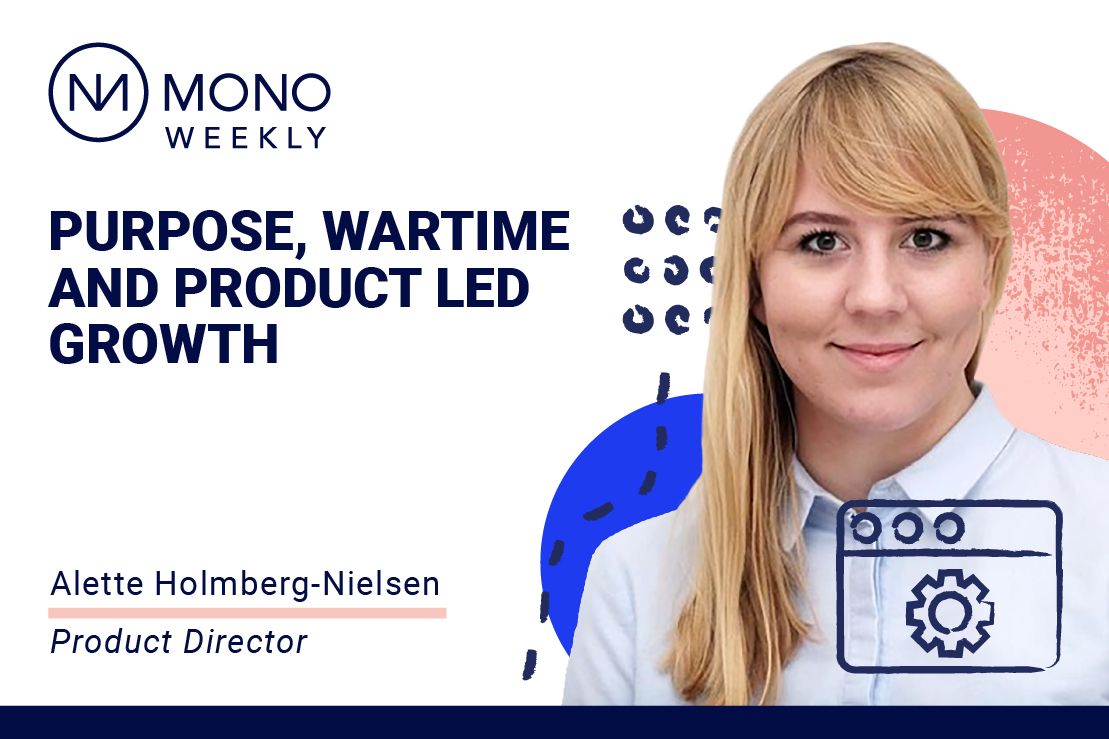
21/01/2021 by Alette Holmberg-Nielsen
Purpose, wartime, and product led growth
To succeed in 2021, product managers need to excel at 3 things: communicating a strong purpose, realizing when it’s wartime, and understanding product led growth.
Fighting the good fight
In 2021, we will see everyone — including product managers— hunting for jobs that allow them to fight the good fight to an even larger degree. Whether it’s products fighting loneliness, reducing carbon footprints, helping local businesses survive, or building medical equipment, everyone who is fortunate enough to have the freedom to choose what they work on will want to do some good. This is part of a larger trend amongst millennials and Gen Zers who are putting people ahead of profits.
"The survey reveals that despite the individual challenges and personal sources of anxiety that millennials and Gen Zs are facing, they have remained focused on larger societal issues, both before and after the onset of the pandemic. If anything, the pandemic has reinforced their desire to help drive positive change in their communities and around the world. And they continue to push for a world in which businesses and governments mirror that same commitment to society, putting people ahead of profits and prioritizing environmental sustainability."
— Deloitte Millenial Survey 2020
For product managers, this means your role is more important than ever when it comes to attracting talent, motivating and retaining your team, and rallying everyone around the same purpose. Good pay, nice colleagues, and a competent boss are no longer enough to attract and retain talent. The fact that the product is making the world a slightly better place is what we all care about.
It’s not news that a strong purpose makes all the difference for a team and its performance as suggested by the following study published in Organization Science. But the emphasis on this is now greater than ever before.
"[…] these results suggest that firms with employees that maintain strong beliefs in the meaning of their work experience better performance."
— Corporate Purpose and Financial Performance (October 9, 2018).
A strong purpose is going to be a competitive advantage in a world where talent is scarce and competition for top talent is fierce. And it’s not the senior executives or the management consultants who are the drivers of that:
"[…] firms exhibiting both high purpose and clarity have systematically higher future accounting and stock market performance, even after controlling for current performance, and that this relation is driven by the perceptions of middle management and professional staff rather than senior executives, hourly or commissioned workers."
— Corporate Purpose and Financial Performance (October 9, 2018).
As a product manager, you play a key part in creating a sense of purpose and meaning within the organization:
- Repeat the purpose of your product as much as possible, in meetings, on posters on the backside of the toilet doors, or in your Slack status. The power of repetition is well documented — but of course, repetition doesn’t make a lie true.
- Remember that not everyone is motivated by numbers, so make sure to express the purpose and progress in other ways as well, e.g., by showing the humans who benefit from your product.
- Introduce the narrative and the purpose to new employees in ways they can remember, give them simple language to use when explaining their company to friends and family, and introduce them to your users as part of their onboarding.
At Mono Solutions, for instance, we help local businesses create professional websites to grow online. We keep these businesses very close to our hearts and we use every opportunity to talk to them about their business and their needs — whether it’s our local tailor or coffee shop doesn’t matter. We bring real businesses as examples to our meetings — not personas — and we take pride in understanding what they’re going through.
Wartime product leaders
In times of crisis, companies are going to need wartime product managers who understand how to relentlessly drive results. For some companies, these wartime product managers will make all the difference for the company, when the future looks dire.
In some industries, like travel, tourism, and hospitality, we’re no longer setting ambitious growth goals like before the pandemic but minimizing damage and fighting for survival. As an example, international tourism went down by 65% in the first half of 2020 when compared with 2019 figures (Infomineo). Product managers in these industries are extremely challenged.
Ben Horowitz has coined many things, including the differences between wartime and peacetime CEOs. Product managers are no different than CEOs in this case.
"A Peacetime CEO sets big, hairy audacious goals. Wartime CEO is too busy fighting the enemy to read management books written by consultants who have never managed a fruit stand."
Obviously, if you’re truly experiencing wartime, you won’t be reading this blogpost either.
Nevertheless, changing your mindset from peacetime to wartime product management means:
- It’s time to get rid of all the time-consuming processes and tools for documentation and tracking of progress. The only thing that matters is the product that’s available to the users.
- If you didn’t care about the business before, now is the time to start understanding the value chain from customer acquisition to churn, so that you can focus your efforts where it makes the most financial sense.
- You need to stop wasting time. Long meetings, hackathons, reading blog posts, and working on nice-to-haves will have to suffer.
- Make decisions with a steady hand. If you don’t have data to base your decisions on, you’ll either have to get it or trust your gut. No matter what you do, it’s important to realize that sometimes a wrong decision is worse than no decision.
From the above, it’s clear that wartime is an opportunity to optimize your workflows in ways that’ll also be beneficial during peacetime. Ben Horowitz also lays out that wartime leaders cannot tolerate creativity and deviations from the plan and won’t be empowering people to make detailed decisions. I disagree because this seems to suggest that in wartime everyone just needs to get in line and execute blindly.
No wartime leader can know it all and as outlined above, a strong understanding of purpose is key to high performance. That’s why even in wartime, building culture, collaboration, and communicating purpose is worthwhile.
In all the frenzy, there is one more thing you shouldn’t sacrifice and that’s the customer experience. After all, your customer experience is your competitive advantage and the foundation of a sustainable business.
Recognizing whether you’re in wartime or peacetime will be the first step to successfully adapting your product management style to this new environment. Be conscious about your style and what the company needs, as well as how to bring your team along with you and you’ll discover that wartime can be a great motivator.
Product led growth
When you’re all set with a strong purpose and wartime product management skills, the final thing you need is an understanding of product led growth — a term coined by Open View Partners in 2016.
"Product led growth (PLG) is an end user-focused growth model that relies on the product itself as the primary driver of customer acquisition, conversion, and expansion."
Product led growth is the idea that you put the end-user first, deliver value before you capture value, and you invest in the product with a go-to-market intent.
Slack, Dropbox, Calendly, and Airtable are famous examples of companies that are able to grow faster by letting the product work to their advantage as a driver for acquisition and conversion.
Putting the end-user first means realizing that it may be the CTO who ends up paying for new software but it’s the employee who signs up for a free account, tries it out, and drives the adoption. Delivering value before capturing value means let the customers experience what your product can do for them before you ask for a credit card.
Investing in the product with go-to-market intent means thinking of the product as a business from the get-go, including tracking that enables steering and experimentation as well as a dedicated growth function.
Following the thinking of product led growth, the product will be at the center of solving all your challenges. If you need more leads, find a way to get the product to help you, like Dropbox did when they started giving you extra space when inviting friends. If you need to help users get set up with your product, let a chatbot guide them, like Slack does when you sign up.
Here is how you as a product manager can take advantage of product led growth:
- Never miss a chance to see people use your product. Whether it’s your mom, your local barista, or a stranger — customer experience is more important than ever.
- Make a version of your product free to use. Or find a way to demonstrate value as early as possible, maybe even before asking people to create an account.
- Let the people in your company give away premium versions of your product to friends and family. Naturally, they’ll find themselves acting as customer success agents and that experience is priceless.
- Build the customer experience before going to market, which means polish the product emails and develop the support — or do the support initially yourself. The product itself may be an MVP, but your customer experience needs to be stellar.
If you understand the dynamics of product led growth, recognize when it’s wartime, and can communicate purposefully, you’ll be a true product leader and 2021.
About the Author
Alette Holmberg-Nielsen is Product Director at Mono Solutions, where she helps teams, product managers and designers ship stellar products and build product culture that eats strategy for breakfast.
What is Mono Weekly?
We’ve gathered our most knowledgeable people in their respective areas who are passionate about the success of small businesses. After all, helping small businesses is the reason why Mono was founded in Copenhagen in 2007.
We will publish a blog post every Thursday of 2021 with a new perspective on website trends, best practices, and common issues that small businesses and re-sellers of marketing technology face every day. Don’t miss a post, sign up today.
